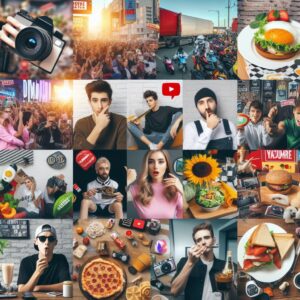Social media is about connection. Platforms like Facebook, Instagram, Twitter, and LinkedIn have redefined the way we communicate, offering unprecedented levels of access to vast networks of people. For businesses, this translates to unparalleled opportunities for brand exposure and customer interaction.
But how do brands rise above the noise? The answer lies in understanding algorithms, creating compelling content, and engaging with audiences in meaningful ways. Social media algorithms favor content that generates interactions – likes, comments, and shares. Brands must craft content that is visually appealing and resonates on a personal level with their target audience.
The analytics provided by these platforms offer deep insights into audience behavior and preferences, enabling marketers to tailor their strategies for maximum impact. Brands can analyze which posts perform best, the demographics of their followers, and the times when their content is most likely to be seen.
Influencer Marketing

Influencer marketing has proven to be one of the most effective digital marketing strategies. To truly resonate with an audience, influencers must align with the brand’s ethos, creating a seamless narrative that weaves the brand’s message with the influencer’s unique voice. This synergy leads to content that feels organic rather than forced, engaging the audience through relatability and credibility.
The real magic of influencer marketing is in its community-driven approach. Successful influencers have often built their followings through consistent, engaging content and by fostering a sense of community among their followers. Their audiences are active participants who often look to these influencers for recommendations and guidance.
Influencers’ content strategies vary. Some create detailed, tutorial-like reviews that educate their audiences about products, while others might integrate product mentions into broader lifestyle content. They can create a buzz around a product launch or amplify brand messaging through stories, posts, and videos.
The engagement that influencers generate is a key metric of their influence. Unlike traditional advertising metrics such as impressions or reach, engagement measures how followers interact with content—through likes, comments, shares, and the duration of video views. A highly engaged audience suggests a strong connection between the influencer and their followers, which can be more valuable than a large but passive audience.
Brands looking to harness the power of influencer marketing must also be mindful of transparency and authenticity. Regulations such as those enforced by the Federal Trade Commission (FTC) in the United States require influencers to disclose when content is sponsored, ensuring that audiences are aware of paid partnerships. This transparency is important in maintaining the trust that is at the core of influencer marketing’s effectiveness.
The landscape of influencer marketing continues to evolve with emerging platforms and shifting consumer habits. Analytics and social listening tools help brands monitor campaigns and adapt strategies in real-time, optimizing their influencer partnerships to achieve the best outcomes. By focusing on these elements, brands can cultivate powerful campaigns that harness the genuine connection between influencers and their audiences to drive engagement, build brand awareness, and ultimately, boost sales.
The Synergy between Social Media and Influencer Marketing
When social media and influencer marketing amalgamate, the results can be synergistic. Influencers can amplify a brand’s message via social media, lending their authority and personal touch. Social media platforms serve as the stage for this marketing performance, providing the tools and analytics to refine and measure its effectiveness.
Here are some steps to maximize the synergy between the two strategies:
Before launching a campaign, identify what success looks like. Is it increased brand awareness, more website traffic, or direct sales? Clear objectives shape the campaign’s direction and measurement.
Understand who you are trying to reach. What are their interests? Which platforms do they frequent? This knowledge will inform your choice of influencer and also the style and substance of the content.
Both social media and influencer content should be relatable and valuable. Whether it’s educational, inspirational, or entertaining, it should resonate on a personal level with the audience.
Genuine relationships between brands, influencers, and audiences are more effective than one-off paid partnerships. Invest in long-term collaborations where influencers become brand advocates.
Use the robust analytic tools provided by social media platforms to track campaign performance. Look at engagement metrics, click-through rates, and conversion statistics. Use these insights to refine campaigns in real time and adapt future strategies.
Social media and influencer marketing are about building communities, creating conversations, and fostering brand loyalty. One feeds into the other, creating a loop of engagement that, when executed well, can lead to a significant return on investment. The brands that understand and apply the principles of these tools effectively are the ones that will thrive in the online marketplace.
As technology continues to advance and consumer behaviors shift, brands that successfully integrate the human touch with their social media presence will emerge as leaders in their respective domains.
